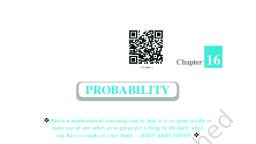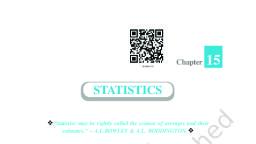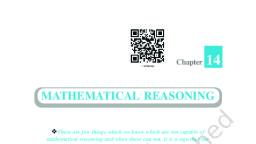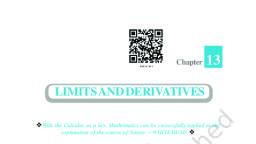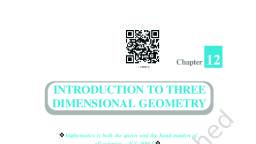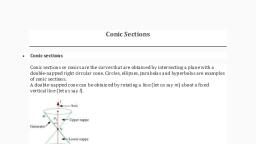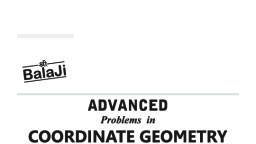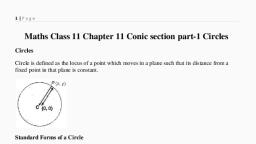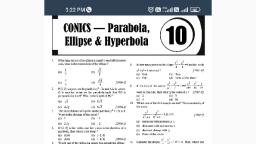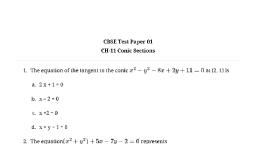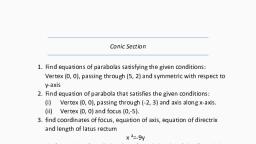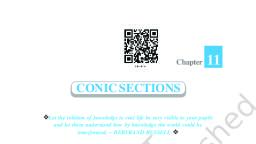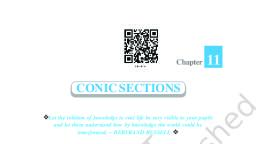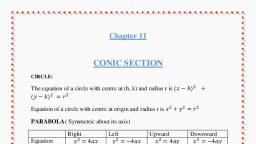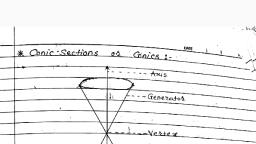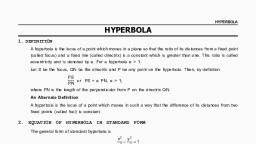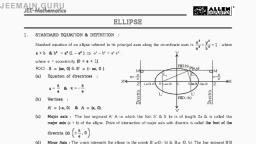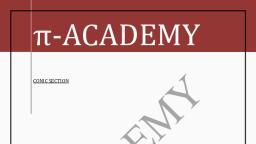Page 1 :
Chapter, , 11, , CONIC SECTIONS, vLet the relation of knowledge to real life be very visible to your pupils, and let them understand how by knowledge the world could be, transformed. – BERTRAND RUSSELL v, , 11.1 Introduction, In the preceding Chapter 10, we have studied various forms, of the equations of a line. In this Chapter, we shall study, about some other curves, viz., circles, ellipses, parabolas, and hyperbolas. The names parabola and hyperbola are, given by Apollonius. These curves are in fact, known as, conic sections or more commonly conics because they, can be obtained as intersections of a plane with a double, napped right circular cone. These curves have a very wide, range of applications in fields such as planetary motion,, Apollonius, (262 B.C. -190 B.C.), design of telescopes and antennas, reflectors in flashlights, and automobile headlights, etc. Now, in the subsequent sections we will see how the, intersection of a plane with a double napped right circular cone, results in different types of curves., , 11.2 Sections of a Cone, Let l be a fixed vertical line and m be another line intersecting it at, a fixed point V and inclined to it at an angle α (Fig11.1)., Suppose we rotate the line m around the line l in such a way, that the angle α remains constant. Then the surface generated is, a double-napped right circular hollow cone herein after referred as, , 2020-21, , Fig 11. 1
Page 2 :
CONIC SECTIONS, , Fig 11. 2, , 237, , Fig 11. 3, , cone and extending indefinitely far in both directions (Fig11.2)., The point V is called the vertex; the line l is the axis of the cone. The rotating line, m is called a generator of the cone. The vertex separates the cone into two parts, called nappes., If we take the intersection of a plane with a cone, the section so obtained is called, a conic section. Thus, conic sections are the curves obtained by intersecting a right, circular cone by a plane., We obtain different kinds of conic sections depending on the position of the, intersecting plane with respect to the cone and by the angle made by it with the vertical, axis of the cone. Let β be the angle made by the intersecting plane with the vertical, axis of the cone (Fig11.3)., The intersection of the plane with the cone can take place either at the vertex of, the cone or at any other part of the nappe either below or above the vertex., 11.2.1 Circle, ellipse, parabola and hyperbola When the plane cuts the nappe (other, than the vertex) of the cone, we have the following situations:, (a) When β = 90o, the section is a circle (Fig11.4)., (b) When α < β < 90o, the section is an ellipse (Fig11.5)., (c) When β = α; the section is a parabola (Fig11.6)., (In each of the above three situations, the plane cuts entirely across one nappe of, the cone)., (d) When 0 ≤ β < α; the plane cuts through both the nappes and the curves of, intersection is a hyperbola (Fig11.7)., , 2020-21
Page 3 :
238, , MATHEMATICS, , Fig 11. 4, , Fig 11. 5, , Fig 11. 7, , Fig 11. 6, , 11.2.2 Degenerated conic sections, When the plane cuts at the vertex of the cone, we have the following different cases:, (a) When α < β ≤ 90o, then the section is a point (Fig11.8)., (b) When β = α, the plane contains a generator of the cone and the section is a, straight line (Fig11.9)., It is the degenerated case of a parabola., (c), , When 0 ≤ β < α, the section is a pair of intersecting straight lines (Fig11.10). It is, the degenerated case of a hyperbola., , 2020-21
Page 4 :
CONIC SECTIONS, , 239, , In the following sections, we shall obtain the equations of each of these conic, sections in standard form by defining them based on geometric properties., , Fig 11. 8, , 11.3 Circle, , Fig 11. 9, , Fig 11. 10, , Definition 1 A circle is the set of all points in a plane that are equidistant from a fixed, point in the plane., The fixed point is called the centre of the circle and the distance from the centre, to a point on the circle is called the radius of the circle (Fig 11.11)., , 2020-21
Page 5 :
240, , MATHEMATICS, , Fig 11. 12, , Fig 11. 11, , The equation of the circle is simplest if the centre of the circle is at the origin., However, we derive below the equation of the circle with a given centre and radius, (Fig 11.12)., Given C (h, k) be the centre and r the radius of circle. Let P(x, y) be any point on, the circle (Fig11.12). Then, by the definition, | CP | = r . By the distance formula,, we have, (x – h)2 + (y – k )2 = r, , i.e., , (x – h)2 + (y – k)2 = r2, , This is the required equation of the circle with centre at (h,k) and radius r ., Example 1 Find an equation of the circle with centre at (0,0) and radius r., Solution Here h = k = 0. Therefore, the equation of the circle is x2 + y2 = r2., Example 2 Find the equation of the circle with centre (–3, 2) and radius 4., Solution Here h = –3, k = 2 and r = 4. Therefore, the equation of the required circle is, (x + 3)2 + (y –2)2 = 16, Example 3 Find the centre and the radius of the circle x2 + y2 + 8x + 10y – 8 = 0, Solution The given equation is, (x2 + 8x) + (y2 + 10y) = 8, Now, completing the squares within the parenthesis, we get, (x2 + 8x + 16) + (y2 + 10y + 25) = 8 + 16 + 25, i.e., (x + 4)2 + (y + 5)2 = 49, i.e., {x – (– 4)}2 + {y – (–5)}2 = 72, Therefore, the given circle has centre at (– 4, –5) and radius 7., , 2020-21
Page 6 :
CONIC SECTIONS, , 241, , Example 4 Find the equation of the circle which passes through the points (2, – 2), and, (3,4) and whose centre lies on the line x + y = 2., Solution Let the equation of the circle be (x – h)2 + (y – k)2 = r2., Since the circle passes through (2, – 2) and (3,4), we have, ... (1), (2 – h)2 + (–2 – k)2 = r2, and (3 – h)2 + (4 – k)2 = r2, ... (2), Also since the centre lies on the line x + y = 2, we have, h+k=2, ... (3), Solving the equations (1), (2) and (3), we get, h = 0.7, k = 1.3 and r2 = 12.58, Hence, the equation of the required circle is, (x – 0.7)2 + (y – 1.3)2 = 12.58., , EXERCISE 11.1, In each of the following Exercises 1 to 5, find the equation of the circle with, 1. centre (0,2) and radius 2, 3. centre (, , 2. centre (–2,3) and radius 4, , 1, 1 1, , ) and radius, 12, 2 4, , 5. centre (–a, –b) and radius, , 4. centre (1,1) and radius, , 2, , a2 − b2 ., , In each of the following Exercises 6 to 9, find the centre and radius of the circles., 6. (x + 5)2 + (y – 3)2 = 36, , 7. x2 + y2 – 4x – 8y – 45 = 0, , 8. x2 + y2 – 8x + 10y – 12 = 0, , 9. 2x2 + 2y2 – x = 0, , 10. Find the equation of the circle passing through the points (4,1) and (6,5) and, whose centre is on the line 4x + y = 16., 11. Find the equation of the circle passing through the points (2,3) and (–1,1) and, whose centre is on the line x – 3y – 11 = 0., 12. Find the equation of the circle with radius 5 whose centre lies on x-axis and, passes through the point (2,3)., 13. Find the equation of the circle passing through (0,0) and making intercepts a and, b on the coordinate axes., 14. Find the equation of a circle with centre (2,2) and passes through the point (4,5)., 15. Does the point (–2.5, 3.5) lie inside, outside or on the circle x2 + y2 = 25?, , 2020-21
Page 7 :
242, , MATHEMATICS, , 11.4 Parabola, Definition 2 A parabola is the set of all points, in a plane that are equidistant from a fixed line, and a fixed point (not on the line) in the plane., The fixed line is called the directrix of, the parabola and the fixed point F is called the, focus (Fig 11.13). (‘Para’ means ‘for’ and, ‘bola’ means ‘throwing’, i.e., the shape, described when you throw a ball in the air)., Note If the fixed point lies on the fixed, A, line, then the set of points in the plane, which, are equidistant from the fixed point and the, fixed line is the straight line through the fixed, point and perpendicular to the fixed line. We, call this straight line as degenerate case of, the parabola., A line through the focus and perpendicular, to the directrix is called the axis of the, parabola. The point of intersection of parabola, with the axis is called the vertex of the parabola, (Fig11.14)., , 11.4.1 Standard equations of parabola The, , Fig 11. 13, , Fig 11.14, , equation of a parabola is simplest if the vertex, is at the origin and the axis of symmetry is along the x-axis or y-axis. The four possible, such orientations of parabola are shown below in Fig11.15 (a) to (d)., , 2020-21
Page 8 :
CONIC SECTIONS, , 243, , Fig 11.15 (a) to (d), , We will derive the equation for the parabola shown above in Fig 11.15 (a) with, focus at (a, 0) a > 0; and directricx x = – a as below:, Let F be the focus and l the directrix. Let, FM be perpendicular to the directrix and bisect, FM at the point O. Produce MO to X. By the, definition of parabola, the mid-point O is on the, parabola and is called the vertex of the parabola., Take O as origin, OX the x-axis and OY, perpendicular to it as the y-axis. Let the distance, from the directrix to the focus be 2a. Then, the, coordinates of the focus are (a, 0), and the, equation of the directrix is x + a = 0 as in Fig11.16., Fig 11.16, Let P(x, y) be any point on the parabola such that, PF = PB,, ... (1), where PB is perpendicular to l. The coordinates of B are (– a, y). By the distance, formula, we have, PF =, , (x – a) 2 + y 2 and PB =, Since PF = PB, we have, , (x + a) 2, , (x – a ) 2 + y 2 = (x + a )2, i.e. (x – a)2 + y2 = (x + a)2, or x2 – 2ax + a2 + y2 = x2 + 2ax + a2, or y2 = 4ax ( a > 0)., , 2020-21
Page 9 :
244, , MATHEMATICS, , Hence, any point on the parabola satisfies, y2 = 4ax., , ... (2), , Conversely, let P(x, y) satisfy the equation (2), PF, , =, , (x – a) 2 + y 2, , =, , (x + a) 2 = PB, , =, , (x – a) 2 + 4ax, , ... (3), , and so P(x,y) lies on the parabola., Thus, from (2) and (3) we have proved that the equation to the parabola with, vertex at the origin, focus at (a,0) and directrix x = – a is y2 = 4ax., Discussion In equation (2), since a > 0, x can assume any positive value or zero but, no negative value and the curve extends indefinitely far into the first and the fourth, quadrants. The axis of the parabola is the positive x-axis., Similarly, we can derive the equations of the parabolas in:, Fig 11.15 (b) as y2 = – 4ax,, Fig 11.15 (c) as x2 = 4ay,, Fig 11.15 (d) as x2 = – 4ay,, These four equations are known as standard equations of parabolas., Note The standard equations of parabolas have focus on one of the coordinate, A, axis; vertex at the origin and thereby the directrix is parallel to the other coordinate, axis. However, the study of the equations of parabolas with focus at any point and, any line as directrix is beyond the scope here., From the standard equations of the parabolas, Fig11.15, we have the following, observations:, 1., , 2., , 3., , Parabola is symmetric with respect to the axis of the parabola.If the equation, has a y2 term, then the axis of symmetry is along the x-axis and if the, equation has an x2 term, then the axis of symmetry is along the y-axis., When the axis of symmetry is along the x-axis the parabola opens to the, (a) right if the coefficient of x is positive,, (b) left if the coefficient of x is negative., When the axis of symmetry is along the y-axis the parabola opens, (c) upwards if the coefficient of y is positive., (d) downwards if the coefficient of y is negative., , 2020-21
Page 10 :
CONIC SECTIONS, , 245, , 11.4.2 Latus rectum, Definition 3 Latus rectum of a parabola is a line segment perpendicular to the axis of, the parabola, through the focus and whose end points lie on the parabola (Fig11.17)., To find the Length of the latus rectum of the parabola y2 = 4ax (Fig 11.18)., By the definition of the parabola, AF = AC., But, , AC = FM = 2a, , Hence, , AF = 2a., , And since the parabola is symmetric with respect to x-axis AF = FB and so, AB = Length of the latus rectum = 4a., , Fig 11.17, , Fig 11.18, , Example 5 Find the coordinates of the focus, axis,, the equation of the directrix and latus rectum of, the parabola y2 = 8x., Solution The given equation involves y2, so the, axis of symmetry is along the x-axis., The coefficient of x is positive so the parabola opens, to the right. Comparing with the given equation, y2 = 4ax, we find that a = 2., , Fig 11.19, , Thus, the focus of the parabola is (2, 0) and the equation of the directrix of the parabola, is x = – 2 (Fig 11.19)., Length of the latus rectum is 4a = 4 × 2 = 8., , 2020-21
Page 11 :
246, , MATHEMATICS, , Example 6 Find the equation of the parabola with focus (2,0) and directrix x = – 2., Solution Since the focus (2,0) lies on the x-axis, the x-axis itself is the axis of the, parabola. Hence the equation of the parabola is of the form either, y2 = 4ax or y2 = – 4ax. Since the directrix is x = – 2 and the focus is (2,0), the parabola, is to be of the form y 2 = 4ax with a = 2. Hence the required equation is, y2 = 4(2)x = 8x, Example 7 Find the equation of the parabola with vertex at (0, 0) and focus at (0, 2)., Solution Since the vertex is at (0,0) and the focus is at (0,2) which lies on y-axis, the, y-axis is the axis of the parabola. Therefore, equation of the parabola is of the form, x2 = 4ay. thus, we have, x2 = 4(2)y, i.e., x2 = 8y., Example 8 Find the equation of the parabola which is symmetric about the y-axis, and, passes through the point (2,–3)., Solution Since the parabola is symmetric about y-axis and has its vertex at the origin,, the equation is of the form x2 = 4ay or x2 = – 4ay, where the sign depends on whether, the parabola opens upwards or downwards. But the parabola passes through (2,–3), which lies in the fourth quadrant, it must open downwards. Thus the equation is of, the form x2 = – 4ay., Since the parabola passes through ( 2,–3), we have, 22 = – 4a (–3), i.e., a =, , 1, 3, , Therefore, the equation of the parabola is, , 1, x2 = − 4 y, i.e., 3x2 = – 4y., 3, , EXERCISE 11.2, In each of the following Exercises 1 to 6, find the coordinates of the focus, axis of the, parabola, the equation of the directrix and the length of the latus rectum., 1. y2 = 12x, , 2. x2 = 6y, , 3., , y2 = – 8x, , 4. x2 = – 16y, , 5. y2 = 10x, , 6., , x2 = – 9y, , In each of the Exercises 7 to 12, find the equation of the parabola that satisfies the, given conditions:, , 2020-21
Page 12 :
CONIC SECTIONS, , 7. Focus (6,0); directrix x = – 6, , 247, , 8. Focus (0,–3); directrix y = 3, , 9. Vertex (0,0); focus (3,0), , 10. Vertex (0,0); focus (–2,0), , 11. Vertex (0,0) passing through (2,3) and axis is along x-axis., 12. Vertex (0,0), passing through (5,2) and symmetric with respect to y-axis., , 11. 5 Ellipse, Definition 4 An ellipse is the set of all points in, a plane, the sum of whose distances from two, fixed points in the plane is a constant., The two fixed points are called the foci (plural, of ‘focus’) of the ellipse (Fig11.20)., Note The constant which is the sum of, A, the distances of a point on the ellipse from the, two fixed points is always greater than the, distance between the two fixed points., , Fig 11.20, , The mid point of the line segment joining the foci is called the centre of the, ellipse. The line segment through the foci of the ellipse is called the major axis and the, line segment through the centre and perpendicular to the major axis is called the minor, axis. The end points of the major axis are called the vertices of the ellipse(Fig 11.21)., , Fig 11.22, , Fig 11.21, , We denote the length of the major axis by 2a, the length of the minor axis by 2b, and the distance between the foci by 2c. Thus, the length of the semi major axis is a, and semi-minor axis is b (Fig11.22)., , 2020-21
Page 13 :
248, , MATHEMATICS, , 11.5.1 Relationship between semi-major, axis, semi-minor axis and the distance of, the focus from the centre of the ellipse, (Fig 11.23)., Take a point P at one end of the major axis., Sum of the distances of the point P to the, foci is F1 P + F2P = F1O + OP + F2P, (Since, F1P = F1O + OP), = c + a + a – c = 2a, , Fig 11.23, , Take a point Q at one end of the minor axis., Sum of the distances from the point Q to the foci is, F1Q + F2Q =, , b2 + c2, , +, , b2 + c2 = 2 b2 + c 2, , Since both P and Q lies on the ellipse., By the definition of ellipse, we have, 2 b 2 + c 2 = 2a, i.e.,, or, , a = b2 + c 2, , a 2 = b2 + c2 , i.e.,, , c=, , a 2 − b2 ., , 11.5.2 Special cases of an ellipse In the equation, c2 = a2 – b2 obtained above, if we keep a fixed and, vary c from 0 to a, the resulting ellipses will vary in, shape., Case (i) When c = 0, both foci merge together with, the centre of the ellipse and a2 = b2, i.e., a = b, and so, the ellipse becomes circle (Fig11.24). Thus, circle is a, special case of an ellipse which is dealt in Section 11.3., Case (ii) When c = a, then b = 0. The ellipse reduces, to the line segment F1F2 joining the two foci (Fig11.25)., , 11.5.3 Eccentricity, , Fig 11.24, , Fig 11.25, , Definition 5 The eccentricity of an ellipse is the ratio of the distances from the centre, of the ellipse to one of the foci and to one of the vertices of the ellipse (eccentricity is, denoted by e) i.e., e =, , c, ., a, , 2020-21
Page 14 :
CONIC SECTIONS, , 249, , Then since the focus is at a distance of c from the centre, in terms of the eccentricity, the focus is at a distance of ae from the centre., 11.5.4 Standard equations of an ellipse The equation of an ellipse is simplest if the, centre of the ellipse is at the origin and the foci are, , (a), Fig 11.26, , on the x-axis or y-axis. The two such possible orientations are shown in Fig 11.26., We will derive the equation for the ellipse shown above in Fig 11.26 (a) with foci, on the x-axis., Let F1 and F2 be the foci and O be the midpoint of the line segment F1F2. Let O be the origin, and the line from O through F2 be the positive, x-axis and that through F1as the negative x-axis., Let, the line through O perpendicular to the, x-axis be the y-axis. Let the coordinates of F1 be, (– c, 0) and F2 be (c, 0) (Fig 11.27)., Let P(x, y) be any point on the ellipse such, that the sum of the distances from P to the two, x2 y 2, +, =1, foci be 2a so given, a 2 b2, PF1 + PF2 = 2a., ... (1), Fig 11.27, Using the distance formula, we have, , ( x + c) 2 + y 2 +, i.e.,, , ( x − c) 2 + y 2 = 2a, , ( x + c) 2 + y 2 = 2a –, , ( x − c )2 + y 2, , 2020-21
Page 16 :
CONIC SECTIONS, , Hence, , PF1 + PF2 = a +, , So, any point that satisfies, , c, c, x + a – x = 2a, a, a, , 251, , ... (3), , x2, y2, +, = 1, satisfies the geometric condition and so, a2, b2, , P(x, y) lies on the ellipse., Hence from (2) and (3), we proved that the equation of an ellipse with centre of, the origin and major axis along the x-axis is, , x2 y 2, +, = 1., a 2 b2, Discussion From the equation of the ellipse obtained above, it follows that for every, point P (x, y) on the ellipse, we have, , x2, y2, =, 1, −, ≤ 1, i.e., x2 ≤ a2, so – a ≤ x ≤ a., a2, b2, Therefore, the ellipse lies between the lines x = – a and x = a and touches these lines., Similarly, the ellipse lies between the lines y = – b and y = b and touches these, lines., Similarly, we can derive the equation of the ellipse in Fig 11.26 (b) as, , x2 y2, +, =1 ., b2 a 2, , These two equations are known as standard equations of the ellipses., Note The standard equations of ellipses have centre at the origin and the, A, major and minor axis are coordinate axes. However, the study of the ellipses with, centre at any other point, and any line through the centre as major and the minor, axes passing through the centre and perpendicular to major axis are beyond the, scope here., From the standard equations of the ellipses (Fig11.26), we have the following, observations:, 1. Ellipse is symmetric with respect to both the coordinate axes since if (x, y) is a, point on the ellipse, then (– x, y), (x, –y) and (– x, –y) are also points on the ellipse., 2. The foci always lie on the major axis. The major axis can be determined by, finding the intercepts on the axes of symmetry. That is, major axis is along the x-axis, if the coefficient of x2 has the larger denominator and it is along the y-axis if the, coefficient of y2 has the larger denominator., , 2020-21
Page 17 :
252, , MATHEMATICS, , 11.5.5 Latus rectum, Definition 6 Latus rectum of an ellipse is a, line segment perpendicular to the major axis, through any of the foci and whose end points, lie on the ellipse (Fig 11.28)., To find the length of the latus rectum, of the ellipse, , x2 y 2, +, =1, a 2 b2, , Let the length of AF2 be l., , Fig 11. 28, , Then the coordinates of A are (c, l ),i.e.,, (ae, l ), Since A lies on the ellipse, , x2 y 2, +, = 1 , we have, a 2 b2, , (ae) 2 l 2, + 2 =1, a2, b, ⇒ l2 = b2 (1 – e2), But, , e2 =, , c2 a 2 – b2, b2, =, =, 1, –, a2, a2, a2, , Therefore, , l2 =, , b4, b2, l, =, ,, i.e.,, a2, a, , Since the ellipse is symmetric with respect to y-axis (of course, it is symmetric w.r.t., both the coordinate axes), AF2 = F2B and so length of the latus rectum is, , 2b2, ., a, , Example 9 Find the coordinates of the foci, the vertices, the length of major axis, the, minor axis, the eccentricity and the latus rectum of the ellipse, x2 y 2, +, =1, 25 9, x2, y2, Solution Since denominator of, is larger than the denominator of, , the major, 25, 9, , 2020-21
Page 18 :
CONIC SECTIONS, , axis is along the x-axis. Comparing the given equation with, , 253, , x2 y 2, +, = 1 , we get, a 2 b2, , a = 5 and b = 3. Also, , c = a 2 – b 2 = 25 – 9 = 4, Therefore, the coordinates of the foci are (– 4,0) and (4,0), vertices are (– 5, 0) and, (5, 0). Length of the major axis is 10 units length of the minor axis 2b is 6 units and the, , 2b 2 18, 4, =, and latus rectum is, ., 5, a, 5, Example 10 Find the coordinates of the foci, the vertices, the lengths of major and, minor axes and the eccentricity of the ellipse 9x2 + 4y2 = 36., , eccentricity is, , Solution The given equation of the ellipse can be written in standard form as, x2 y2, +, =1, 4, 9, y2, x2, is larger than the denominator of, , the major axis is, 9, 4, along the y-axis. Comparing the given equation with the standard equation, , Since the denominator of, , x2 y2, +, = 1 , we have b = 2 and a = 3., b2 a 2, Also, , c=, , and, , e=, , a2 – b2, , =, , 9–4= 5, , c, 5, =, a, 3, , Hence the foci are (0, 5 ) and (0, – 5 ), vertices are (0,3) and (0, –3), length of the, major axis is 6 units, the length of the minor axis is 4 units and the eccentricity of the, 5, ., 3, Example 11 Find the equation of the ellipse whose vertices are (± 13, 0) and foci are, (± 5, 0)., Solution Since the vertices are on x-axis, the equation will be of the form, , ellipse is, , x2 y 2, +, = 1 , where a is the semi-major axis., a 2 b2, , 2020-21
Page 19 :
254, , MATHEMATICS, , Given that a = 13, c = ± 5., Therefore, from the relation c2 = a2 – b2, we get, 25 = 169 – b2 , i.e., b = 12, Hence the equation of the ellipse is, , x2, y2, +, = 1., 169 144, , Example 12 Find the equation of the ellipse, whose length of the major axis is 20 and, foci are (0, ± 5)., Solution Since the foci are on y-axis, the major axis is along the y-axis. So, equation, of the ellipse is of the form, , x2 y2, +, =1., b2 a 2, , Given that, , 20, = 10, 2, , a = semi-major axis =, , c 2 = a2 – b2 gives, 52 = 102 – b2 i.e., b2 = 75, Therefore, the equation of the ellipse is, , and the relation, , x2, y2, +, =1, 75 100, , Example 13 Find the equation of the ellipse, with major axis along the x-axis and, passing through the points (4, 3) and (– 1,4)., Solution The standard form of the ellipse is, and (–1, 4) lie on the ellipse, we have, , and, , x2, y2, = 1. Since the points (4, 3), +, a2, b2, , 16, 9, + 2 =1, 2, a, b, , ... (1), , 1, 16, + 2 =1, 2, a, b, , ….(2), , 2, Solving equations (1) and (2), we find that a =, , Hence the required equation is, , 2020-21, , 247, 247, 2, and b =, ., 7, 15
Page 20 :
CONIC SECTIONS, , 255, , x2, y2, +, = 1 , i.e., 7x2 + 15y2 = 247., 247 247, , , 7 15, , EXERCISE 11.3, In each of the Exercises 1 to 9, find the coordinates of the foci, the vertices, the length, of major axis, the minor axis, the eccentricity and the length of the latus rectum of the, ellipse., 1., , x2 y2, +, =1, 36 16, , 4., , x2, y2, +, =1, 25 100, , 7. 36x2 + 4y2 = 144, , 2., , x2 y2, +, =1, 4 25, , 3., , x2 y2, +, =1, 16 9, , 5., , x2 y 2, +, =1, 49 36, , 6., , x2, y2, +, =1, 100 400, , 8. 16x2 + y2 = 16, , 9. 4x2 + 9y2 = 36, , In each of the following Exercises 10 to 20, find the equation for the ellipse that satisfies, the given conditions:, 10., 11., 12., 13., , Vertices (± 5, 0), foci (± 4, 0), Vertices (0, ± 13), foci (0, ± 5), Vertices (± 6, 0), foci (± 4, 0), Ends of major axis (± 3, 0), ends of minor axis (0, ± 2), , Ends of major axis (0, ± 5 ), ends of minor axis (± 1, 0), Length of major axis 26, foci (± 5, 0), Length of minor axis 16, foci (0, ± 6)., Foci (± 3, 0), a = 4, b = 3, c = 4, centre at the origin; foci on the x axis., Centre at (0,0), major axis on the y-axis and passes through the points (3, 2) and, (1,6)., 20. Major axis on the x-axis and passes through the points (4,3) and (6,2)., , 14., 15., 16., 17., 18., 19., , 11.6 Hyperbola, Definition 7 A hyperbola is the set of all points in a plane, the difference of whose, distances from two fixed points in the plane is a constant., , 2020-21
Page 21 :
256, , MATHEMATICS, , Fig 11.29, , The term “difference” that is used in the definition means the distance to the, farther point minus the distance to the closer point. The two fixed points are called the, foci of the hyperbola. The mid-point of the line segment joining the foci is called the, centre of the hyperbola. The line through the foci is called the transverse axis and, the line through the centre and perpendicular to the transverse axis is called the conjugate, axis. The points at which the hyperbola, intersects the transverse axis are called the, vertices of the hyperbola (Fig 11.29)., We denote the distance between the, two foci by 2c, the distance between two, vertices (the length of the transverse axis), by 2a and we define the quantity b as, b =, , c2 – a2, , Also 2b is the length of the conjugate axis, (Fig 11.30)., , Fig 11.30, , To find the constant P1F2 – P1F1 :, By taking the point P at A and B in the Fig 11.30, we have, BF1 – BF2 = AF2 – AF1 (by the definition of the hyperbola), BA +AF1– BF2 = AB + BF2– AF1, i.e., AF1 = BF2, So that, BF1 – BF2 = BA + AF1– BF2 = BA = 2a, , 2020-21
Page 22 :
CONIC SECTIONS, , 257, , 11.6.1 Eccentricity, c, is called the eccentricity of the, a, hyperbola. Since c ≥ a, the eccentricity is never less than one. In terms of the, eccentricity, the foci are at a distance of ae from the centre., Definition 8 Just like an ellipse, the ratio e =, , 11.6.2 Standard equation of Hyperbola The equation of a hyperbola is simplest if, the centre of the hyperbola is at the origin and the foci are on the x-axis or y-axis. The, two such possible orientations are shown in Fig11.31., , (b), , (a), Fig 11.31, , We will derive the equation for the hyperbola shown in Fig 11.31(a) with foci on, the x-axis., Let F1 and F2 be the foci and O be the mid-point of the line segment F1F2. Let O, be the origin and the line through O, through F2 be the positive x-axis and, that through F 1 as the negative, x-axis. The line through O, perpendicular to the x-axis be the, y-axis. Let the coordinates of F1 be, (– c,0) and F2 be (c,0) (Fig 11.32)., Let P(x, y) be any point on the, hyperbola such that the difference, of the distances from P to the farther, point minus the closer point be 2a., So given, PF1 – PF2 = 2a, Fig 11.32, , 2020-21
Page 23 :
258, , MATHEMATICS, , Using the distance formula, we have, (x + c ) 2 + y 2 – (x – c ) 2 + y 2 = 2a, (x + c ) 2 + y 2 = 2a + (x – c) 2 + y 2, , i.e.,, , Squaring both side, we get, (x – c ) 2 + y 2 + (x – c)2 + y2, , (x + c)2 + y2 = 4a2 + 4a, and on simplifying, we get, , cx, –a=, a, , (x – c) 2 + y 2, , On squaring again and further simplifying, we get, x2, y2, –, =1, a 2 c2 – a2, , x2 y 2, –, =1, a 2 b2, , i.e.,, , (Since c2 – a2 = b2), , x2 y 2, –, = 1 1., a 2 b2, Conversely, let P(x, y) satisfy the above equation with 0 < a < c. Then, , Hence any point on the hyperbola satisfies, , y, Therefore,, , 2, , = b, , 2, , PF1 = +, = +, , Similarly,, , PF2 = a –, , x2 – a2 , , , 2, a, , , (x + c ) 2 + y 2, x2 – a2 , c, (x + c )2 + b 2 , x, = a+, 2, a, a, , , , a, x, c, , In hyperbola c > a; and since P is to the right of the line x = a, x > a,, a–, , c, c, x becomes negative. Thus, PF2 =, x – a., a, a, , 2020-21, , c, x > a. Therefore,, a
Page 24 :
CONIC SECTIONS, , 259, , c, cx, x –, + a = 2a, a, a, Also, note that if P is to the left of the line x = – a, then, Therefore, , PF1 – PF2 = a +, , c , , c, PF1 = – a + x , PF2 = a – x ., a , a, , In that case P F2 – PF1 = 2a. So, any point that satisfies, , x2 y 2, –, = 1 , lies on the, a 2 b2, , hyperbola., Thus, we proved that the equation of hyperbola with origin (0,0) and transverse axis, along x-axis is, , x2 y 2, –, =1., a 2 b2, , ANote A hyperbola in which a = b is called an equilateral hyperbola., Discussion From the equation of the hyperbola we have obtained, it follows that, we, , x2, y2, =, 1, +, have for every point (x, y) on the hyperbola, 2, ≥ 1., a, b2, i.e,, , x, ≥ 1, i.e., x ≤ – a or x ≥ a. Therefore, no portion of the curve lies between the, a, , lines x = + a and x = – a, (i.e. no real intercept on the conjugate axis)., Similarly, we can derive the equation of the hyperbola in Fig 11.31 (b) as, , y 2 x2, − =1, a 2 b2, , These two equations are known as the standard equations of hyperbolas., Note The standard equations of hyperbolas have transverse and conjugate, A, axes as the coordinate axes and the centre at the origin. However, there are, hyperbolas with any two perpendicular lines as transverse and conjugate axes, but, the study of such cases will be dealt in higher classes., From the standard equations of hyperbolas (Fig11.29), we have the following, observations:, 1., , Hyperbola is symmetric with respect to both the axes, since if (x, y) is a point on, the hyperbola, then (– x, y), (x, – y) and (– x, – y) are also points on the hyperbola., , 2020-21
Page 25 :
260, , MATHEMATICS, , 2., , The foci are always on the transverse axis. It is the positive term whose, denominator gives the transverse axis. For example,, has transverse axis along x-axis of length 6, while, , x2 y 2, –, =1, 9 16, , y 2 x2, –, =1, 25 16, , has transverse axis along y-axis of length 10., 11.6.3 Latus rectum, Definition 9 Latus rectum of hyperbola is a line segment perpendicular to the transverse, axis through any of the foci and whose end points lie on the hyperbola., 2b 2, ., a, Example 14 Find the coordinates of the foci and the vertices, the eccentricity,the, length of the latus rectum of the hyperbolas:, , As in ellipse, it is easy to show that the length of the latus rectum in hyperbola is, , (i), , x2 y2, –, = 1 , (ii) y2 – 16x2 = 16, 9 16, , Solution (i) Comparing the equation, , x2 y 2, –, = 1 with the standard equation, 9 16, , x2 y 2, –, =1, a 2 b2, Here, a = 3, b = 4 and c =, , a 2 + b 2 = 9 + 16 = 5, , Therefore, the coordinates of the foci are (± 5, 0) and that of vertices are (± 3, 0).Also,, , c 5, 2b 2 32, =, =, =, The eccentricity e =, . The latus rectum, a 3, a, 3, (ii) Dividing the equation by 16 on both sides, we have, , Comparing the equation with the standard equation, a = 4, b = 1 and c = a 2 + b2 = 16 + 1 = 17 ., , 2020-21, , y 2 x2, –, =1, 16 1, , y 2 x2, –, = 1 , we find that, a 2 b2
Page 26 :
CONIC SECTIONS, , Therefore, the coordinates of the foci are (0, ±, (0, ± 4). Also,, , 261, , 17 ) and that of the vertices are, , 2b2 1, 17, c, = ., =, . The latus rectum, The eccentricity e = =, a, 4, a, 2, Example 15 Find the equation of the hyperbola with foci (0, ± 3) and vertices, (0, ±, , 11, )., 2, , Solution Since the foci is on y-axis, the equation of the hyperbola is of the form, , y 2 x2, =1, –, a 2 b2, Since vertices are (0, ±, , 11, ), a =, 2, , 11, 2, , Also, since foci are (0, ± 3); c = 3 and b2 = c2 – a2 =, , 25, ., 4, , Therefore, the equation of the hyperbola is, x2, y2, –, = 1, i.e., 100 y2 – 44 x2 = 275., 11 25 , , 4 4 , , Example 16 Find the equation of the hyperbola where foci are (0, ±12) and the length, of the latus rectum is 36., Solution Since foci are (0, ± 12), it follows that c = 12., , 2b 2, = 36 or b2 = 18a, Length of the latus rectum =, a, c2 = a2 + b2; gives, 144 = a2 + 18a, a2 + 18a – 144 = 0,, i.e.,, a = – 24, 6., So, Since a cannot be negative, we take a = 6 and so b2 = 108., , Therefore, , Therefore, the equation of the required hyperbola is, , 2020-21, , x2, y2, = 1 , i.e., 3y2 – x2 = 108, –, 36 108
Page 27 :
262, , MATHEMATICS, , EXERCISE 11.4, In each of the Exercises 1 to 6, find the coordinates of the foci and the vertices, the, eccentricity and the length of the latus rectum of the hyperbolas., x2 y2, y 2 x2, –, =1, –, =1, 2., 3. 9y2 – 4x2 = 36, 16 9, 9 27, 4. 16x2 – 9y2 = 576, 5. 5y2 – 9x2 = 36, 6. 49y2 – 16x2 = 784., In each of the Exercises 7 to 15, find the equations of the hyperbola satisfying the given, conditions., 7. Vertices (± 2, 0), foci (± 3, 0), 8. Vertices (0, ± 5), foci (0, ± 8), 9. Vertices (0, ± 3), foci (0, ± 5), 10. Foci (± 5, 0), the transverse axis is of length 8., 11. Foci (0, ±13), the conjugate axis is of length 24., , 1., , 12. Foci (± 3 5 , 0), the latus rectum is of length 8., 13. Foci (± 4, 0), the latus rectum is of length 12, 14. vertices (± 7,0), e =, , 4, ., 3, , 15. Foci (0, ± 10 ), passing through (2,3), , Miscellaneous Examples, Example 17 The focus of a parabolic mirror as shown in Fig 11.33 is at a distance of, 5 cm from its vertex. If the mirror is 45 cm deep, find, the distance AB (Fig 11.33)., Solution Since the distance from the focus to the, vertex is 5 cm. We have, a = 5. If the origin is taken at, the vertex and the axis of the mirror lies along the, positive x-axis, the equation of the parabolic section is, y2 = 4 (5) x = 20 x, Note that, x = 45. Thus, y2 = 900, Therefore, y = ± 30, Hence, , AB = 2y = 2 × 30 = 60 cm., , Fig 11.33, Example 18 A beam is supported at its ends by, supports which are 12 metres apart. Since the load is concentrated at its centre, there, , 2020-21
Page 28 :
CONIC SECTIONS, , 263, , is a deflection of 3 cm at the centre and the deflected beam is in the shape of a, parabola. How far from the centre is the deflection 1 cm?, Solution Let the vertex be at the lowest point and the axis vertical. Let the coordinate, axis be chosen as shown in Fig 11.34., , Fig 11.34, , The equation of the parabola takes the form x2 = 4ay. Since it passes through, , 3 , 3 , 36 ×100, = 300 m, 6,, , we have (6)2 = 4a , , i.e., a =, 12, 100 , 100 , Let AB be the deflection of the beam which is, Therefore, i.e., , x 2 = 4 × 300 ×, x=, , 24, , 1, 2, m. Coordinates of B are (x,, )., 100, 100, , 2, = 24, 100, , = 2 6 metres, , Example 19 A rod AB of length 15 cm rests in between two coordinate axes in such, a way that the end point A lies on x-axis and end point B lies on, y-axis. A point P(x, y) is taken on the rod in such a way, that AP = 6 cm. Show that the locus of P is an ellipse., Solution Let AB be the rod making an angle θ with, OX as shown in Fig 11.35 and P (x, y) the point on it, such that, AP = 6 cm., Since, AB = 15 cm, we have, PB = 9 cm., From P draw PQ and PR perpendiculars on y-axis and, x-axis, respectively., , 2020-21, , Fig 11.35
Page 29 :
264, , MATHEMATICS, , From, , ∆ PBQ, cos θ =, , x, 9, , From, , ∆ PRA, sin θ =, , y, 6, , Since, , cos2 θ + sin2 θ = 1, 2, , 2, , x y, + =1, 9 6, , or, , x2 y2, + =1, 81 36, , Thus the locus of P is an ellipse., , Miscellaneous Exercise on Chapter 11, 1., 2., , If a parabolic reflector is 20 cm in diameter and 5 cm deep, find the focus., An arch is in the form of a parabola with its axis vertical. The arch is 10 m high, and 5 m wide at the base. How wide is it 2 m from the vertex of the parabola?, , 3., , The cable of a uniformly loaded suspension bridge hangs in the form of a parabola., The roadway which is horizontal and 100 m long is supported by vertical wires, attached to the cable, the longest wire being 30 m and the shortest being 6 m., Find the length of a supporting wire attached to the roadway 18 m from the, middle., , 4., , An arch is in the form of a semi-ellipse. It is 8 m wide and 2 m high at the centre., Find the height of the arch at a point 1.5 m from one end., , 5., , A rod of length 12 cm moves with its ends always touching the coordinate axes., Determine the equation of the locus of a point P on the rod, which is 3 cm from, the end in contact with the x-axis., Find the area of the triangle formed by the lines joining the vertex of the parabola, x2 = 12y to the ends of its latus rectum., , 6., 7., , A man running a racecourse notes that the sum of the distances from the two flag, posts from him is always 10 m and the distance between the flag posts is 8 m., Find the equation of the posts traced by the man., , 8., , An equilateral triangle is inscribed in the parabola y2 = 4 ax, where one vertex is, at the vertex of the parabola. Find the length of the side of the triangle., , 2020-21
Page 30 :
CONIC SECTIONS, , Summary, In this Chapter the following concepts and generalisations are studied., , ® A circle is the set of all points in a plane that are equidistant from a fixed point, in the plane., , ® The equation of a circle with centre (h, k) and the radius r is, (x – h)2 + (y – k)2 = r2., , ® A parabola is the set of all points in a plane that are equidistant from a fixed, line and a fixed point in the plane., , ® The equation of the parabola with focus at (a, 0) a > 0 and directrix x = – a is, y2 = 4ax., ® Latus rectum of a parabola is a line segment perpendicular to the axis of the, parabola, through the focus and whose end points lie on the parabola., ® Length of the latus rectum of the parabola y2 = 4ax is 4a., ® An ellipse is the set of all points in a plane, the sum of whose distances from, two fixed points in the plane is a constant., , ® The equation of an ellipse with foci on the x-axis is, , x2 y 2, + =1., a 2 b2, , ® Latus rectum of an ellipse is a line segment perpendicular to the major axis, through any of the foci and whose end points lie on the ellipse., , ® Length of the latus rectum of the ellipse, , x2 y 2, 2b 2, +, =, 1, is, ., a 2 b2, a, , ® The eccentricity of an ellipse is the ratio between the distances from the centre, of the ellipse to one of the foci and to one of the vertices of the ellipse., ® A hyperbola is the set of all points in a plane, the difference of whose distances, from two fixed points in the plane is a constant., , x2 y 2, ® The equation of a hyperbola with foci on the x-axis is : a 2 − b 2 = 1, , 2020-21, , 265
Page 31 :
266, , MATHEMATICS, , ® Latus rectum of hyperbola is a line segment perpendicular to the transverse, axis through any of the foci and whose end points lie on the hyperbola., , x2 y 2, 2b2, −, =, 1, Length, of, the, latus, rectum, of, the, hyperbola, :, is, :, ., ®, a, a 2 b2, , ® The eccentricity of a hyperbola is the ratio of the distances from the centre of, the hyperbola to one of the foci and to one of the vertices of the hyperbola., , Historical Note, Geometry is one of the most ancient branches of mathematics. The Greek, geometers investigated the properties of many curves that have theoretical and, practical importance. Euclid wrote his treatise on geometry around 300 B.C. He, was the first who organised the geometric figures based on certain axioms, suggested by physical considerations. Geometry as initially studied by the ancient, Indians and Greeks, who made essentially no use of the process of algebra. The, synthetic approach to the subject of geometry as given by Euclid and in, Sulbasutras, etc., was continued for some 1300 years. In the 200 B.C., Apollonius, wrote a book called ‘The Conic’ which was all about conic sections with many, important discoveries that have remained unsurpassed for eighteen centuries., Modern analytic geometry is called ‘Cartesian’ after the name of Rene, Descartes (1596-1650) whose relevant ‘La Geometrie’ was published in 1637., But the fundamental principle and method of analytical geometry were already, discovered by Pierre de Fermat (1601-1665). Unfortunately, Fermats treatise on, the subject, entitled Ad Locus Planos et So LIDOS Isagoge (Introduction to, Plane and Solid Loci) was published only posthumously in, 1679. So, Descartes came to be regarded as the unique inventor of the analytical, geometry., Isaac Barrow avoided using cartesian method. Newton used method of, undetermined coefficients to find equations of curves. He used several types of, coordinates including polar and bipolar. Leibnitz used the terms ‘abscissa’,, ‘ordinate’ and ‘coordinate’. L’ Hospital (about 1700) wrote an important textbook, on analytical geometry., Clairaut (1729) was the first to give the distance formula although in clumsy, form. He also gave the intercept form of the linear equation. Cramer (1750), , 2020-21
Page 32 :
CONIC SECTIONS, , 267, , made formal use of the two axes and gave the equation of a circle as, ( y – a)2 + (b – x)2 = r, He gave the best exposition of the analytical geometry of his time. Monge, (1781) gave the modern ‘point-slope’ form of equation of a line as, y – y′ = a (x – x′), and the condition of perpendicularity of two lines as aa′ + 1 = 0., S.F. Lacroix (1765–1843) was a prolific textbook writer, but his contributions, to analytical geometry are found scattered. He gave the ‘two-point’ form of, equation of a line as, , y –β=, , β′ – β, (x – α), α′ – α, , and the length of the perpendicular from (α, β) on y = ax + b as, , (β – a – b ), 1 + a2, , ., , a′ – a , His formula for finding angle between two lines was tan θ = 1 + aa′ . It is, of, , , course, surprising that one has to wait for more than 150 years after the invention, of analytical geometry before finding such essential basic formula. In 1818, C., Lame, a civil engineer, gave mE + m′E′ = 0 as the curve passing through the, points of intersection of two loci E = 0 and E′ = 0., Many important discoveries, both in Mathematics and Science, have been, linked to the conic sections. The Greeks particularly Archimedes (287–212 B.C.), and Apollonius (200 B.C.) studied conic sections for their own beauty. These, curves are important tools for present day exploration of outer space and also for, research into behaviour of atomic particles., , —v —, , 2020-21
Page 33 :
CBSE Class 11 Study Material, Printable Worksheets for Class 11, NCERT Solutions for Class 11, , NCERT Solutions for class 11 Maths, NCERT Solutions for class 11 Physics, NCERT Solutions for class 11 Chemistry, NCERT Solutions for class 11 Biology, NCERT Solutions for class 11 English, NCERT Solutions for Class 11 English, Woven Words Essay, NCERT Solutions for Class 11 English, Woven Short Stories, NCERT Solutions for Class 11 English, Woven Words Poetry, NCERT Solutions for class 11 Accountancy, NCERT Solutions for class 11 Business, Studies, NCERT Solutions for class 11 Economics, NCERT Solutions for class 11 Computer, Science – Python, Class 11 Hindi Aroh (आरोह भाग 1), , , Class 11 Hindi Vitan (वितान भाग 1)
Page 34 :
Class 11 Sanskrit, Class 11 History, Class 11 Geography, Class 11 Indian Economic Development, Class 11 Statistics for Economics, Class 11 Political Science, Class 11 Psychology, Class 11 Sociology, Class 11 Entrepreneurship, Maths formulas for Class 11, Hindi Grammar for Class 11, Class 11 English Hornbill Summaries, Class 11 English Snapshots Summaries, CBSE Sample Papers for Class 11, NCERT Exemplar Class 11 Maths Solutions, NCERT Exemplar Class 11 Physics Solutions, NCERT Exemplar Class 11, Chemistry Solutions, NCERT Exemplar Class 11 Biology Solutions, RD Sharma Class 11 Solutions, CBSE Class 11 and 12 Revised Syllabus, MCQ Questions
Page 35 :
CBSE Class 11 Physics Manual, CBSE Class 11 Chemistry Manual, Trigonometry Formulas, Integration Formulas, JEE Main Study Material, NEET Study Material, CBSE Class 11 Notes, Class 11 Maths Notes, Class 11 Physics Notes, Class 11 Chemistry Notes, Class 11 Biology Notes, Class 11 English Notes, Class 11 English Woven Words Short Stories, CBSE Class 11 English Woven Words Essay, CBSE Class 11 English Woven Words Poetry, CBSE Class 11 English Snapshots, CBSE Class 11 English Hornbill, Class 11 Business Studies Notes, Class 11 Accountancy Notes, Class 11 Psychology Notes, Class 11 Entrepreneurship Notes, Class 11 Economics Notes
Page 36 :
Class 11 Indian Economic Development, Notes, Statistics for Economics Class 11 Notes, Class 11 Political Science Notes, Class 11 History Notes, Sociology Class 11 Notes, Geography Class 11 Notes, NCERT Books for Class 11, , Class 11 NCERT Maths Books, Class 11 Physics NCERT Book, Class 11 Chemistry NCERT Book, Class 11 Biology NCERT Book, Class 11 Political Theory Part-I, Class 11 NCERT Business Studies Books, Class 11 India Constitution at Work, NCERT Geography Book Class 11, NCERT Class 11 History Book, Class 11 India Economic Development, Class 11 NCERT English Books, NCERT Sanksrit Books Class 11, Class 11 Computer and Communication, Technology Book, Class 11 NCERT Accountancy Books
Page 37 :
Class 11 Statistics, Class 11 Introduction to Psychology, Class 11 Introducing Sociology, Class 11 Understanding Society, Class 11 Fine Arts, Class 11 Heritage Craft Books, Class 11 Nai Awaz, Class 11 Dhanak, Class 11 The story of Graphic Design, Class 11 Human Ecology and Family, Sciences
















